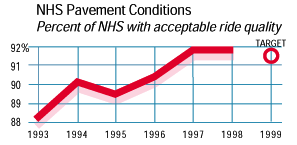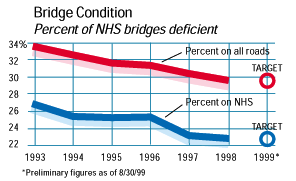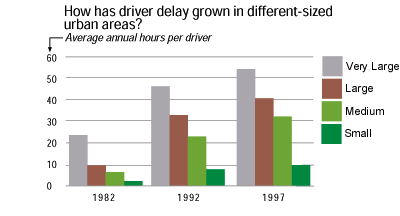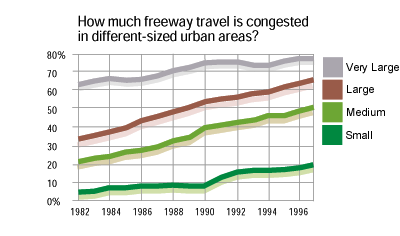| Connecting America - 1999 Report to the Nation | 9 of 16 |
MobilityContinually improve the public's access to activities, goods, and services through preservation, improvement, and expansion of the highway transportation system and enhancement of its operations, efficiency, and intermodal connections.Mobility, as much as any other factor, defines us as a nation. Almost 90 percent of all personal transportation takes place on highways. They connect people with work, school, community services, markets, and each other. By connecting air, transit, rail, and port facilities and terminals, highways have become the backbone of the nation's intermodal transportation system. Through this goal, we provide national leadership for continually improving the quality of our infrastructure and its operations. We research longer-life pavements, build more environmentally friendly facilities, and use better techniques for reconstructing highways to minimize delays. Constructing new highways has given way to maximizing the capacity of our existing highways. Improving operations of existing facilities has been successfully employed to better manage the country's growing air traffic demands. Through better operations, a doubling of air traffic over the past two decades is being managed with only small increases in the number of new runways and airports. NHS Pavement Conditions Measure for Success: Increase the percentage of the National Highway System (NHS) that meets the acceptable ride quality standard.  We know how important it is for people to get where they want to go without the disruption and discomfort of poor pavements. Pavements in poor condition increase the costs of operating a vehicle, add to delay and congestion, and can become a safety hazard. Improving the smoothness of pavement increases our ability to move goods, services, and people more effectively and efficiently. While more than 90 percent of pavement is rated as acceptable, traffic continues to grow by 3 to 5 percent per year, making critical the need for more durable and reliable pavements on our vital road network. The Superpave System, a new method for asphalt pavement material selection and design, was developed in collaboration with the state highway agencies under the Strategic Highway Research Program to improve the performance of pavement and the lifespan of existing roads. Superpave is also cost-effective and efficient. In 1999, it was used in 35 states and in more than 3,000 construction projects. With Superpave, we have not only achieved a longer-lasting, tougher pavement, but also an estimated savings of more than $1.5 billion a year. In addition, there are fewer delays and less frequent roadway repairs, meaning increased safety for drivers and highway workers. Bridge Conditions Measure for Success: Improve the condition of America's bridges.  There are more cars, more drivers, more--and bigger--trucks, and more lane miles as states have widened and rebuilt original Interstate roadways. At some point, all of this traffic must cross over a bridge. Today, although safe, more than 20 percent of bridges are no longer capable of meeting their daily traffic demands. Many were built when the Interstate first emerged and they are now in need of replacement or improvement. FHWA provides direct funding for bridge construction and maintenance, and is researching new types of bridges that can be built faster and be made to last longer.
Mobility of Pedestrians and Bicyclists We are working with other federal, state, and local agencies to increase the miles of trails, highways, and roads that are accessible to pedestrians and bicyclists. This will result in a higher percentage of personal trips being taken by pedestrians and bicyclists, and provide greater access for persons with disabilities. Prior to recent federal legislation, state and local officials selected bicycle/pedestrian projects totaling only $3 to $4 million per year in federal-aid highway funds. Currently, federal funds spent for pedestrian/bicycle projects have averaged $248.8 million a year. These funds have been generated from transportation enhancement activities and the Congestion Mitigation and Air Quality Improvement Program (CMAQ). To help states identify and address pedestrian and bicycle safety and mobility concerns, FHWA provides technical assistance to federal, state, and local agencies. As a result, there has been increasing emphasis on pedestrian and bicycle safety issues in transportation planning across the country. Urban Congestion Congestion--especially in urban areas--is of growing concern to the public. People hate to sit in traffic. To find better solutions for urban congestion, we are examining national measures that have been developed and tracked over time. One such measure, produced by the Texas Transportation Institute, focuses on congestion in terms of driver delay and congested freeway travel in 68 large metropolitan areas. By almost any measure, traffic congestion has been growing over the last two decades in both large metropolitan areas and in small urban areas (less than 500,000 population). In fact, smaller urban areas have seen peak period congestion grow more rapidly than large metropolitan areas. In 1982, only one-third of peak period travel was congested in smaller urban areas, while in 1997 two-thirds was congested. During the same years, the percentage of travel in the small urban areas increased from 14 percent to 36 percent during congested peak periods. ITS will provide important tools to minimize some of the causes of urban congestion. For example, highway accidents consume as much as one-third of highway capacity during rush hour. Cameras, sensors, and other ITS technologies can give us real-time information on accidents or broken-down vehicles blocking travel lanes so that they can be removed more quickly. Advanced traffic and freeway management systems can adjust automatically to the dynamics of traffic flow such as adjusting traffic signals or providing alternative travel route information. The advent of the Internet, coupled with wireless communication, will allow this information to be at the driver's fingertips. The driver can then make better decisions on when to travel, what routes to take, and where to park. Commuters can learn when the next bus is coming.  
AccomplishmentsIntelligent Roads--Now That's SmartIn Houston, Texas, the traffic management system includes ramp metering, closed-circuit television, variable message signs, a high-occupancy vehicle (HOV) lane system, a regional computerized traffic signal system, emergency management operations, and a motorist assistance program. Total user savings are estimated at $8.5 million per year. In Atlanta, Georgia, the NaviGator traffic management system has saved highway travelers $44.6 million annually by providing real-time response to incidents using vehicles equipped with Global Positioning Systems (GPS). In Portland, Oregon, the integrated bus priority and traffic signal system on a major surface highway allows buses to extend "green" time or shorten "red" time by a few seconds--enough to cut bus travel time by 5 to 8 percent and require fewer buses to service the route. In more than 40 metropolitan areas across the United States, more accurate traffic information is now being provided to the traveling public on the Internet, television, radio, cellular telephones, and pagers. Peak Performance in Puerto RicoTwo "access to the mountain" projects were opened to the public in the municipalities of Aguas Buenas and San Sebastian, Puerto Rico. This effort improved the transportation infrastructure of key towns in the central mountains, replacing low-speed, crash-prone, winding, and steep segments of two highways in Puerto Rico. The new modern multilane highways have improved roadside safety, cut travel time in half, increased mobility, provided access to coastal urban centers, and promoted economic development in the central and western mountain regions. |
|
Related Links: |